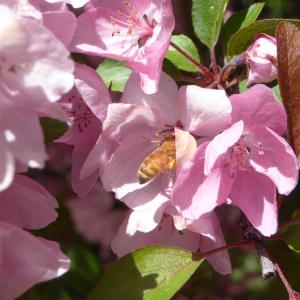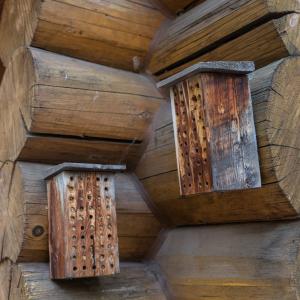Each year Montana Public Radio hosts a fund raising event to help finance their programs. They cajole their listeners into donating money to support their favorite radio shows and they offer what they call premiums for making donations at certain levels. These premiums are gifts that local listeners contribute and are, more often than not, eclectic, unique, homemade items that end up being loads for fun for all involved – the giver, the receiver, and fellow listeners. Odd sounding, off the wall, engaging premiums have become a signature of Montana Public Radio’s annual fundraising events and have served to make thousands of connections throughout the community.
Dunrovin Ranch has been both a giver and a receiver of these premiums. In fact, one of our loveliest assets came to us via a Montana Public Radio premium. When we first moved to Dunrovin, we had almost no experience with orchards and flowering trees. Upon making our first donation to Montana Public Radio, Sterling decided that he would select a premium that consisted of a scion from a listener’s apple tree that purportedly produced the most delicious apples imaginable to be grafted onto our own apple tree. Well, this sounded like a hoot. We had never imaged grafting one tree to another, and we we anxious to learn.
On the appointed day, a delightful gentleman arrived at Dunrovin with several scions in hand and set about to graft them to our tree while we watched and asked all sort of simple minded questions revealing our total ignorance of managing an orchard. He was most patient and most helpful. Not only did he complete his appointed task, but he asked us if we had cultivated any orchard mason bees. Well, of course not. We had never even heard of mason orchard bees, and we certainly had no idea of how to culture them. After listening to him extol their many virtues which included that they are native to Montana, very shy, do not live in hives, and do not sting, we were eager to lure them to our newly planted orchard. This meant simply installing a “bee box” with individual holes drilled, and supplying a source of moist clay for them to use to plug their individual nests.
This man was so generous and so committed to getting us get going, that he returned the next week with a couple of bee boxes that he had built. They were immediately installed on the side of our log home, and for two years, I faithfully maintained a pot with moist clay right under them to give the bees access to the mud essential for their homes. Sure enough, within several years, we had hordes of mason bees anxious to pollinate our ever growing number of both true fruit bearing and ornamental fruit trees. Happily, our orchard routinely produces an abundance of cherries, apples, pears, and plums each year. In addition, the scion that was grafted more than lived up to it billing. We routinely fight over who gets the apples from that part of the tree!
Regrettably, I do not remember the name of this kind and very knowledgeable man who grafted the scion to our apple tree and who helped us so many years ago to get mason orchard bees established at Dunrovin. But I do remember his wonderful personality. And I remember his great Montana story which is not atypical of others who live here. When we asked him what he did, he immediately responded by saying, ” Well, I am a poet. That is what I am, but I can’t make a living as a poet. So, I make my living as a carpenter and I moved here to live amid the Montana mountains that inspire my poetry. Fruit trees are my passion.” Thank you, Montana Public Radio, for bringing this most remarkable man to Dunrovin.
These many years later, our population of mason bees flourishes and bewitches all of our spring guests. As the flowering crab apple trees that surround our guest lodging bloom, the trees come alive with the sound of the thousands of mason bees busily visiting each and every bloom. Kids of all ages – from two to ninety – stand entranced beneath the trees and listen. They just listen to the overwhelming buzz knowing full well that they are in no danger from these friendly little insects. It’s pure magic! You can listen for yourself!
 SuzAnne Miller is the owner of Dunrovin Ranch. A fourth-generation Montanan, SuzAnne grew up roaming the mountains and fishing the streams of western Montana. Her love of nature, animals, science, and education prompted her to create the world’s first cyber ranch where live web cameras bring Dunrovin’s wildlife and ranch life to internet users across the globe.
SuzAnne Miller is the owner of Dunrovin Ranch. A fourth-generation Montanan, SuzAnne grew up roaming the mountains and fishing the streams of western Montana. Her love of nature, animals, science, and education prompted her to create the world’s first cyber ranch where live web cameras bring Dunrovin’s wildlife and ranch life to internet users across the globe.
You can find her blog at: http://dunrovinranchmontana.com/blog/




